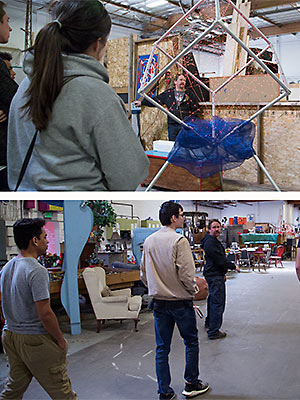
The Generator's technical director, Lindsay Adams, offers an initial tour of the facility to TMCC architecture students, who will be building their full-scale model at the site.
Previously in Part 1 and Part 2 of this series, TMCC student James Severt is inspired to design single-unit transitional housing for individuals who are homeless. Architecture Instructor Kreg Mebust brings three architecture classes into the project, and the City of Reno supports the students’ efforts. Students do preliminary research before moving into the design phase.
Architecture students at Truckee Meadows Community College have completed their pre-design research on the scope and impact of homelessness, and are more committed than ever to come up with sustainable plans to build models of temporary single-unit housing for fellow Northern Nevadans in need.
Their task is to design a transitional housing model for those who are homeless. It will be a small 80-square-foot individual detached living unit or “pod.” The pod would be equipped with electricity. Bathrooms and sinks are to be located in a separate building shared by all in a group of units.
James Severt, architecture major and student project manager for the project said the design energy is seriously flowing to the plans and design drawings.
“There are a ton of ideas pouring in,” Severt said.
Fellow student Kaysi Archey agrees. She is also the second vice president of the TMCC American Institute of Architects Student Chapter (AIAS).
“We develop the ideas together in class,” Archey said.
Everyone works independently and then they share their work with others as they go around the room and check out what fellow classmates have designed.
Some ideas that the students are exploring include the following:
- Modular design for moving individual units
- Individual or six-unit heating system
- Multi-unit cooling system
- Trombe wall that absorbs heat and then releases it gradually
- Thermal mass water system to help moderate hot and cold exterior temperatures
- A solar cell and Tesla Powerwall battery design to power each six units
“A solar cell and Powerwall battery can cut electricity costs by two-thirds,” Severt said.
Individual Pods for Individuals
“We’d allow the tenants to personalize the space in some way,” Archey said. “There will also be furniture in the unit.”
The students would like the individuals occupying their newly designed spaces to be positively affected by living there.
“Maybe an artist; they could paint or spray paint on panels attached to the wall and then be removable,” Severt said. “Or the painting becomes an avenue back into school to continue their education.”
Narrowing Down the Ideas
“We had to consider a lot of ideas, breaking them down, and deciding which are the ideas that work the best,” Archey said. “We had to consider environmental factors, durability, sustainability. One important factor is the materials—are they local or do they have to be transported? How much heat can they hold—that’s the thermal mass, and their mobility. All of that affects the architectural design.”
Severt added that they are shooting for a design that would be easily implemented by the City of Reno.
“The pods have to be mobile, and we have to think about the community—the human element,” Severt added. “There are two communities—the homeless population and the greater community, including government. The way the community will decide and agree is if we can build it as inexpensively as possible, working for both communities.”
They’re hoping for the best.
“When the two communities come together and agree, something very powerful will happen,” Severt added.
Moving Toward Actually Constructing a Unit
“Architects should be learning from a book and they should also look at what they’re putting together in the real environment,” said Kreg Mebust, Architecture Professor. “That’s the learning process—learning on paper and building in the actual building environment.”
Soon, the TMCC architecture classes will be working on their community build project from The Generator, a maker-space at 1240 Icehouse Ave., in Reno.
“We’ll be at The Generator space this week, and we’ll have the design solidified,” said Kreg Mebust, Architecture Professor. “Materials will be ordered and delivered to the design site, The Generator.”
Severt is eager to begin.
“We’ll be creating sawdust on April 10,” he said. “The Generator is open 24 hours a day, and so we can work on the build during class time and out of class time.”
An Unveiling Date is Set
The “Pod” model unveiling has been set for Friday, May 4, in the early evening. It will be held in the William N. Pennington Applied Technology Center hub, with a possible guest speaker. Students will be inviting guests, media representatives, city and state officials, and those who have supported them throughout their project.
For more information about the community architecture project, please contact Architecture Instructor Kreg Mebust at 775-673-7265.
Coming in Part 4
Individuals and organizations from the community donate mentorship and materials to make the architecture students’ pod model a reality.






